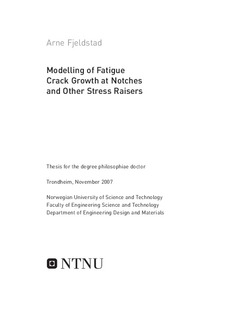| dc.contributor.author | Fjeldstad, Arne | nb_NO |
| dc.date.accessioned | 2014-12-19T12:26:01Z | |
| dc.date.available | 2014-12-19T12:26:01Z | |
| dc.date.created | 2008-01-11 | nb_NO |
| dc.date.issued | 2007 | nb_NO |
| dc.identifier | 123227 | nb_NO |
| dc.identifier.isbn | 978-82-471-5112-9 | nb_NO |
| dc.identifier.uri | http://hdl.handle.net/11250/241303 | |
| dc.description.abstract | This thesis consists of an introduction and eight papers [1–8]. Paper 1 presents simple and flexible methods to enhance the fatigue life of welded aluminium components. The key element of the methods is to change residual stresses from tension to compression at locations vulnerable to fatigue crack growth. This is accomplished by mechanical pre-stressing using elastic pre-deformation or thermal pre-stressing using induction heating. Based on fatigue test results induction heating tuned out to be the most promising method.
In Paper 2, an approximate method based on asymptotic solutions for estimating the stress intensity factor for cracks at stress concentrations is presented. The proposed solution makes use of the near-notch and remote-notch solution to interpolate over the entire range from shallow to deep cracks. Paper 3 extends the theory presented in Paper 2 to cover through-cracked plates of finite width subjected to bending or tension. Paper 4 examines how a decreasing stress field influences the fatigue crack growth. Even though the stress generally decreases from a maximum at some critical point, fatigue crack growth analyses are often performed assuming a homogeneous stress state to avoid the difficulties related to crack growth analyses in complex components. The degree of conservatism has been determined by comparing the calculated fatigue life of cracks growing in a homogeneous stress field with the fatigue life of cracks growing in a gradient stress field. In Paper 5, an approximate method based on asymptotic solutions for estimating the stress intensity factor for cracked V-notched plates is presented. The proposed solutions make use of a reference solution to interpolate from shallow to deep cracks. The reference solution is obtained by considering the current crack emanating from the associated specimen with a sharp notch. It is showed how the proposed theory can be used for estimating the stress intensity factor for a crack located at the root of a weld toe in a T-joint.
Paper 6 and 7 presents the probabilistic fatigue assessment tool, P•FAT, for the fatigue analysis of arbitrary components. General concepts which have to be considered for the accomplishment of a 3D fatigue crack simulation by postprocessing results from a standard finite element analysis are introduced. General features such as determination of the life controlling defect, fatigue strength and fatigue life distribution, and probability of component failure, have been presented. Furthermore, a new short crack growth model that accounts for short crack growth is presented. In Paper 8, the short crack growth model is used to predict the arrest of cracks growing in stress gradient fields. The predictions have been compared with experimentally obtained data for notched specimens and found to agree well. | nb_NO |
| dc.language | eng | nb_NO |
| dc.publisher | Fakultet for ingeniørvitenskap og teknologi | nb_NO |
| dc.relation.ispartofseries | Doktoravhandlinger ved NTNU, 1503-8181; 2007:231 | nb_NO |
| dc.relation.haspart | Tveiten, Bård Wathne. Fatigue life enhancement of aluminium joints through mechanical and thermal prestressing. International Journal of Fatigue. 28(12): 1667-1676, 2006. | nb_NO |
| dc.relation.haspart | Wormsen, Anders; Fjeldstad, Arne; Härkegård, Gunnar. The application of asymptotic solutions to a semi-elliptical crack at the root of a notch. Engineering Fracture Mechanics. 73(13): 1899-1912, 2006. | nb_NO |
| dc.relation.haspart | Fjeldstad, Arne; Härkegård, Gunnar; Wormsen, Anders. The influence of a stress gradient on the growth of a fatigue crack. Proceedings of the International Fatigue Congress, Atlanta, USA, 2006. | nb_NO |
| dc.relation.haspart | Fjeldstad, Arne; Wormsen, Anders; Härkegård, Gunnar. Approximate stress intensity factors for cracked V-notched specimens based on asymptotic solutions with application to T-joints. Engineering Fracture Mechanics. 75(5): 1083-1098, 2008. | nb_NO |
| dc.relation.haspart | Fjeldstad, Arne; Wormsen, Anders; Härkegård, Gunnar. Simulation of fatigue crack growth in components with random defects. Engineering Fracture Mechanics. 75(5): 1184-1203, 2008. | nb_NO |
| dc.relation.haspart | Wormsen, Anders; Fjeldstad, Arne; Härkegård, Gunnar. post-processor for fatigue crack growth analysis based on a finite element stress field. Computer Methods in Applied Mechanics and Engineering. 197(6-8): 834-845, 2008. | nb_NO |
| dc.relation.haspart | Fjeldstad, Arne; Wormsen, Anders; Härkegård, Gunnar. A reanalysis of Frost’s classical fatigue tests on self-arresting cracks at notches. . | nb_NO |
| dc.title | Modelling of Fatigue Crack Growth at Notches and Other Stress Raisers | nb_NO |
| dc.type | Doctoral thesis | nb_NO |
| dc.contributor.department | Norges teknisk-naturvitenskapelige universitet, Fakultet for ingeniørvitenskap og teknologi, Institutt for produktutvikling og materialer | nb_NO |
| dc.description.degree | PhD i produktutvikling og materialer | nb_NO |
| dc.description.degree | PhD in Engineering Design and Materials | en_GB |
